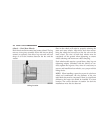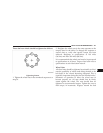
6. Start the engine in the vehicle which has the booster
battery, let the engine idle a few minutes, then start the
engine in the vehicle with the discharged battery.
7. When removing the jumper cables, reverse the above
sequence exactly. Be careful of the moving belts and fan.
WARNING!
Any procedure other than above could result in:
•
Personal injury caused by electrolyte squirting out
the battery vent.
•
Personal injury or property damage due to battery
explosion.
•
Damage to charging system of booster vehicle or
of immobilized vehicle.
FREEING A STUCK VEHICLE
If the vehicle becomes stuck in snow, sand, or mud, it can
often be moved by a rocking motion. Move the shift lever
rhythmically between DRIVE and REVERSE, while ap-
plying slight pressure to the accelerator.
In general, the least amount of accelerator pedal pressure
to maintain the rocking motion without spinning the
wheels or racing the engine, is most effective. Racing the
engine or spinning the wheels, due to the frustration of
not freeing the vehicle, may lead to transmission over-
heating and failure. Allow the engine to idle with the
shift lever in NEUTRAL for at least one minute after
every five rocking-motion cycles. This will minimize
overheating and reduce the risk of transmission failure
during prolonged efforts to free a stuck vehicle.
WHAT TO DO IN EMERGENCIES 421
6


















